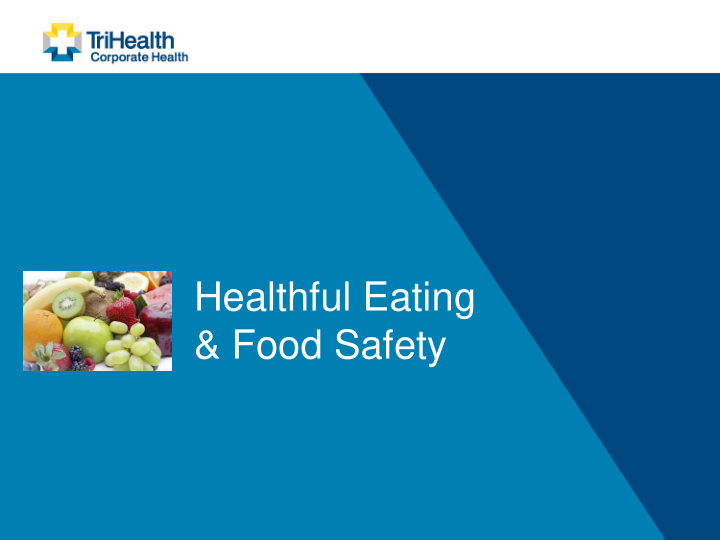



Healthful Eating & Food Safety
Healthful Eating & Food Safety What Does It Mean to “Eat Clean?” Choos hoose whole, natural foods. • Elim imin inate ultra-processed foods such as those found • in boxes, cans or packages. Foc ocus on nutrient-rich foods such as fresh fruit & vegetables, unrefined grains, • unprocessed meats, etc. Include some protein, carbohydrates, and healthy fat in your meals. In • Eat extra vegetables to stay fuller longer. • Re Read labels. Look for a short list of ingredients and be able to pronounce them. • Consume Co me five to six small meals throughout the day. • Avoi oid high-fat cooking methods. • Shop hop the grocery store’s perimeter; the inner aisles contain mostly processed foods. •
Healthful Eating & Food Safety Practice Food Safety: • Avoi oid Cr Cros oss Con Conta taminati tion on Chop veggies on separate cutting board from raw meat. Wash anything that comes into contact with raw meat with hot, soapy water. Wipe down surfaces with anti-bacterial spray. • Was ash T h Tho hose e Hand ands Using hot, soapy water, scrub hands at least 20 seconds before cooking & after handling raw meat. • Use e a F a Food T Ther hermomet eter er Make sure to cook meat to a safe, internal temperature. Do not judge only on its appearance. • Keep F Food ood H Hot ot (or or Col Cold) According to FoodSafety.gov, bacteria multiply quickest in the “danger zone”— between 40⁰ and 140⁰ Fahrenheit. To avoid this, wait to put out hot and cold food until it’s time to eat. Use chafing dishes or slow cookers to keep food hot, and don’t leave cold food out past two hours.
Healthful Eating & Food Safety Safe Minimum Cooking Temperatures CATEGORY FOOD TEMPERATURE(°F) REST TIME Ground Meat & Meat Mixtures Beef, Pork, Veal, Lamb 160 None Turkey, Chicken 165 None Fresh Beef, Veal, Lamb Steaks, roasts, chops 145 3 minutes Poultry Chicken & Turkey, whole 165 None Poultry breasts, roasts 165 None Poultry thighs, legs, wings 165 None Duck & Goose 165 None Stuffing (cooked alone or in bird) 165 None Pork and Ham Fresh pork 145 3 minutes Fresh ham (raw) 145 3 minutes Precooked ham (to reheat) 140 None Eggs & Egg Dishes Eggs Cook until yolk and white are firm None Egg dishes 160 None Leftovers & Casseroles Leftovers 165 None Casseroles 165 None Seafood Fin Fish 145 or cook until flesh is opaque and None separates easily with a fork. Shrimp, lobster, and crabs Cook until flesh is pearly and opaque. None Clams, oysters, and mussels Cook until shells open during cooking. None Scallops Cook until flesh is milky white or None opaque and firm. Source: Foodsafety.gov
Healthful Eating & Food Safety Should You Be Gluten-Free?” Gluten: en: Protein found in wheat, rye, and other grains. • Cel eliac ac Di Diseas ease: e: Autoimmune disorder passed down through • families. When someone with Celiac Disease eats or drinks anything with gluten, the immune system responds by damaging the intestinal track. Sympt mptoms I ms Incl clude de: • Abdominal pain, bloating, gas, or indigestion • Constipation • Decreased appetite(also could be increased or unchanged) • Diarrhea, either constant or intermittent • Lactose Intolerance • Nausea or vomiting • Stools that float, are foul smelling, or bloody • Unexplained weight loss • Anyone experiencing these symptoms or considering a gluten-free diet fir irst should consult his or her doctor for an appropriate diagnosis.
Recommend
More recommend